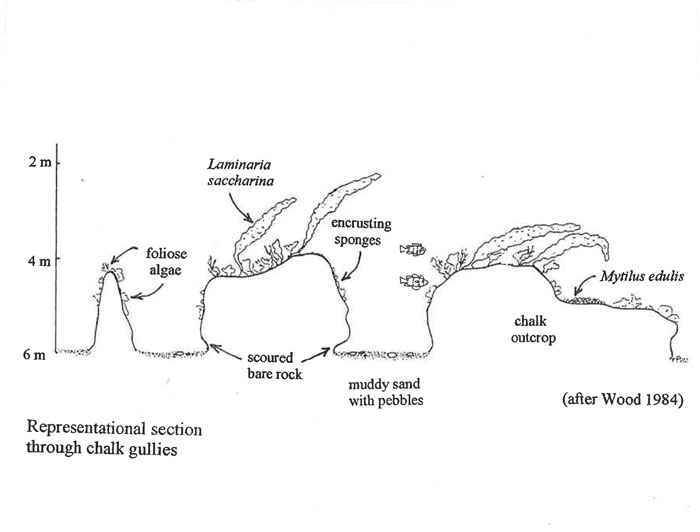SUSSEX MARINE SITES OF NATURE CONSERVATION IMPORTANCE
| Site: Subtidal wave-cut chalk platform (Brighton-Newhaven) | Ref. No. 21 | ||||||
| Location: East of Brighton Marina to Newhaven breakwater (11 km in length) | Other conservation designation?: No |
||||||
| Lat./Long. position of centre of site: 50° 47' 57" N 0° 1' 27" W |
OS grid ref. of centre of site: TQ 394 011 |
Author: Robert Irving |
|||||
| Sea bed type: Dissected chalk platform with ridges and gullies - site extends from mid-shore to approx. 750 m seaward. |
Depth range (below chart datum): 6-1 m |
Date identified: June 2001 |
|||||
Summary
The foreshore between Brighton Marina and the Newhaven breakwater (approximately 11 km in length) comprises a wave-cut chalk platform which extends beyond low water mark into the shallow sublittoral. On the lower shore and beyond, the platform has been eroded into a number of low-lying ridges and gullies which extend for approximately 300-500 m out to sea. The ridges become less distinct as one moves further away from the shore, until the chalk bedrock eventually becomes covered by sand.
Biological Description
Beyond low water mark, the chalk bedrock has been eroded into a series of flat-floored gullies with prominent ridges in between, aligned perpendicular to the shore. The height of the ridges is greatest closest to the shore (1.2 m being the maximum recorded), reducing to just 20-30 cm further out. Similarly, the gullies may be 1.2 m wide closest to the shore, but reduce to 20-30 cm further out. The sides of the gullies are usually concave, but on occasion are vertical or undercut. The gully floors have a light covering of sand or silt, with occasional chalk and flint cobbles too. The ridges between the gullies tend to be flat-topped with up to 90% cover of foliose red algae on upward-facing surfaces, as well as some encrusting calcareous growths. Most surfaces have silt deposited on them. The surface of the chalk bedrock is pitted by holes - mostly caused by piddocks, but with smaller ones resulting from the actions of boring worms such as spionids and horseshoe worms Phoronis hippocrepia. The ridges and gully sides are often covered with tightly-packed mussels Mytilus edulis (often with accompanying common starfish Asterias rubens), and also barnacles. Sponges recorded from here include the gooseÂbump sponge Dysidea fragilis and Halichondria bowerbanki, together with silt-tolerant ascidians Molgula spp., the antenna hydroid Nemertesia antennina and occasional anemones (including small plumose Metridium senile and dahlia anemones Urticina felina). Mobile species include spiny spider crabs Maja squinado, velvet swimming crab Necora puber, and hermit crabs. Fishes include many small bib Trisopterus luscus, ballan wrasse Labrus bergylta and small gobies Pomatoschistus spp.
Little life is apparent on the patches of sand encroaching the seaward end of the gullies. Infauna includes occasional sandmason worms Lanice conchilega, lugworms Arenicola marina, and heart urchins Echinocardium cordatum. Apparent on the surface may be netted dogwhelks Hinia reticulata, common whelks Buccinum undatum, hermit crabs, flatfish, and even juvenile rays.
Justification
Sublittoral chalk exposures are unusual within the British Isles, with the vast majority being found in the South East. The wave-cut platform between Brighton and Newhaven displays the characteristic features of gully and ridge topography, with their associated biological communities.
References:Irving, R. A. 1999. Report of the Sussex Seasearch Project, 1992-1998 Sussex SEASEARCH Project, English Nature, Lewes, and Brighton & Hove Council, Brighton |
|||||||
| Sussex SEASEARCH dive nos.: 714/2-5, 7, 10, 11, 19-21, 48-50, 715/37, 38, 713/13, 16, 18, 19 | |||||||
| Sussex Sublittoral Survey site no.: 82/13, 83.31 & 33 | |||||||
Site Location

Diagrammatic representation of site: Subtidal wave-cut chalk platform (Brighton-Newhaven)


:Link to this page
Copyright Sussex Biodiversity Records Centre © 2025